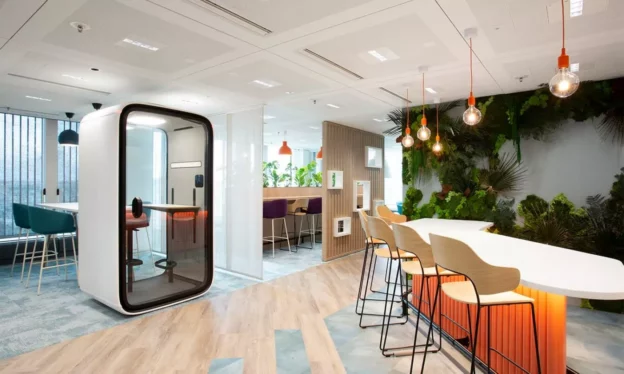Office design and space planning are more than just aesthetic choices—they play a pivotal role in driving corporate success. A well-thought-out office environment can significantly impact employee productivity, collaboration, and overall organizational efficiency. Here’s how strategic office design and space planning contribute to a company’s success.
1. Enhances Employee Productivity An effectively designed office can boost employee productivity by creating a conducive working environment. Ergonomic furniture, adequate lighting, and well-planned layouts reduce discomfort and distractions, allowing employees to focus on their tasks. A comfortable and functional workspace leads to higher job satisfaction and more efficient work performance.
2. Fosters Collaboration and Innovation Office design can facilitate collaboration and innovation by incorporating spaces that encourage teamwork. Open floor plans, collaborative workstations, and dedicated meeting areas enable employees to interact and share ideas more freely. When employees have access to flexible spaces designed for brainstorming and teamwork, creativity and innovation are more likely to flourish.
3. Reflects Company Culture The design of an office space serves as a reflection of a company’s culture and values. A well-designed office communicates the company’s identity to both employees and clients. Incorporating brand colors, values, and visual elements into the design can strengthen the company’s image and create a cohesive and engaging environment.
4. Improves Employee Well-being Office design plays a crucial role in employee well-being. Incorporating elements such as natural light, indoor plants, and comfortable break areas contributes to a healthier and more pleasant work environment. A focus on employee well-being not only improves job satisfaction but also reduces absenteeism and turnover rates.
5. Optimizes Space Utilization Effective space planning ensures that every square foot of an office is utilized efficiently. By analyzing the needs of different departments and functions, companies can design layouts that maximize space usage and minimize wasted areas. This optimization leads to cost savings and a more organized, functional workspace.
6. Supports Flexibility and Adaptability In today’s dynamic business environment, flexibility is key. Office design should accommodate changing needs and growth. Modular furniture, adjustable workstations, and multi-purpose areas allow for easy reconfiguration and adaptation to new workflows or team structures, ensuring that the space evolves with the organization.
7. Enhances Recruitment and Retention A well-designed office can be a powerful tool for attracting and retaining top talent. Modern, stylish, and functional workspaces make a strong impression on potential hires and contribute to a positive employee experience. Investing in a high-quality office environment can enhance your company’s reputation as an employer of choice.
8. Boosts Employee Engagement Engaged employees are more likely to be productive and committed to their work. A thoughtfully designed office can boost engagement by creating an environment that aligns with employees’ needs and preferences. Features such as comfortable lounges, vibrant color schemes, and collaborative areas contribute to a more engaging and motivating workspace.
9. Facilitates Effective Communication Office design can influence the flow of communication within a company. Strategically placed meeting rooms, open communication areas, and clear sightlines help facilitate effective interactions between team members. An office layout that supports easy communication enhances coordination and reduces misunderstandings.
10. Contributes to Sustainable Practices Modern office design often includes sustainable practices that contribute to corporate social responsibility. Energy-efficient lighting, eco-friendly materials, and waste reduction strategies not only benefit the environment but also align with the growing demand for corporate sustainability. A green office design can enhance your company’s reputation and appeal to environmentally conscious stakeholders.
In conclusion, office design and space planning are integral to corporate success. By creating a workspace that enhances productivity, fosters collaboration, and reflects company culture, organizations can achieve a competitive edge and drive overall success. Thoughtful design and strategic planning ensure that the office environment supports the needs of both employees and the business, contributing to long-term growth and achievement.
